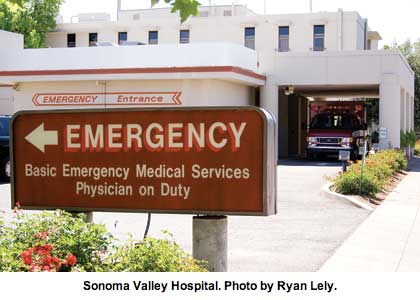
“There are lies, damn lies and statistics,” said Dr. Clinton Lane, quoting Mark Twain at the Sonoma Valley Hospital’s strategic planning meeting Wednesday.
“I’ve been sitting here on this committee and listening to surveys, and most of the elections were lost,” he said. “This [latest survey] looks better than everything we’ve seen, but it shouldn’t make people more overconfident.”
The June 2008 survey showed the most optimistic numbers yet about the community’s support of the hospital and the bond hospital officials say they need to keep it running. Still, the question posed by the committee was, can they trust it?
Hospital CEO Carl Gerlach said he’d come to realize the people who come to the meetings don’t necessarily represent the entire community. “So I turn to the survey,” he said, explaining that he saw the survey as a management tool, and a way to avoid making assumptions. “That’s why I did this survey and why I’ll do it again and again.” Hospital board chair Dick Kirk agreed. “This is a method of listening to the public,” he said.
Carolyn Barber, of Dresner, Wickers and Associates who conducted the survey, explained that it consisted of 300 telephone interviews, randomly selected from the voting register, done between June 16 and June 19. Among the positive findings was that 53 percent considered the hospital excellent or above average. Highest among the positive responses, she said, was that people don’t want to lose the emergency room. Of the negatives, she said, no single argument was stronger than the weakest positive statement. She said the negatives could be grouped under the heading “confidence,” as in: “How do we know what you’re saying about this will really get done?”
Alden Brosseau responded, “It shows how critical credibility is. If we can say anything to the board it’s that we’ve got to be totally honest to the electorate. We’ve got to say what’s actually true and not flinch.” Gina Cuclis agreed. “I would caution jumping to any conclusions about how you state the message, not confuse the bond with the parcel tax. Don’t be jumping to conclusions.”
Among the public comment, concerns were raised about this particular election and that with the numbers of issues on the ballot this would be near the bottom. To that, Gina Cuclis said, “What the political experts tend to say is the high voter turn out elections tend to be progressive voters. Progressives tend to vote for tax measures. In terms of the down ballot, the smart sales taxes are all down ballot. There’s a supervisor race, city council race, there’s a get out the vote method for down ballot campaign.
Committee chair Richard Fogg said the registrar of voters says she expects an 80 percent turnout. In the commentary, it was seen as positive that people seem to understand a single issue ballot and would be responsive to it, but that that underscored the need to be extremely careful and not misleading. “No mention of ‘until a new hospital is built,” one commentator said. Brosseau reiterated the theme of the evening: the importance of clarity. “Again,” he said, “if you say explicitly what you’re going to use the money for, you’ll be in a stronger position.”




